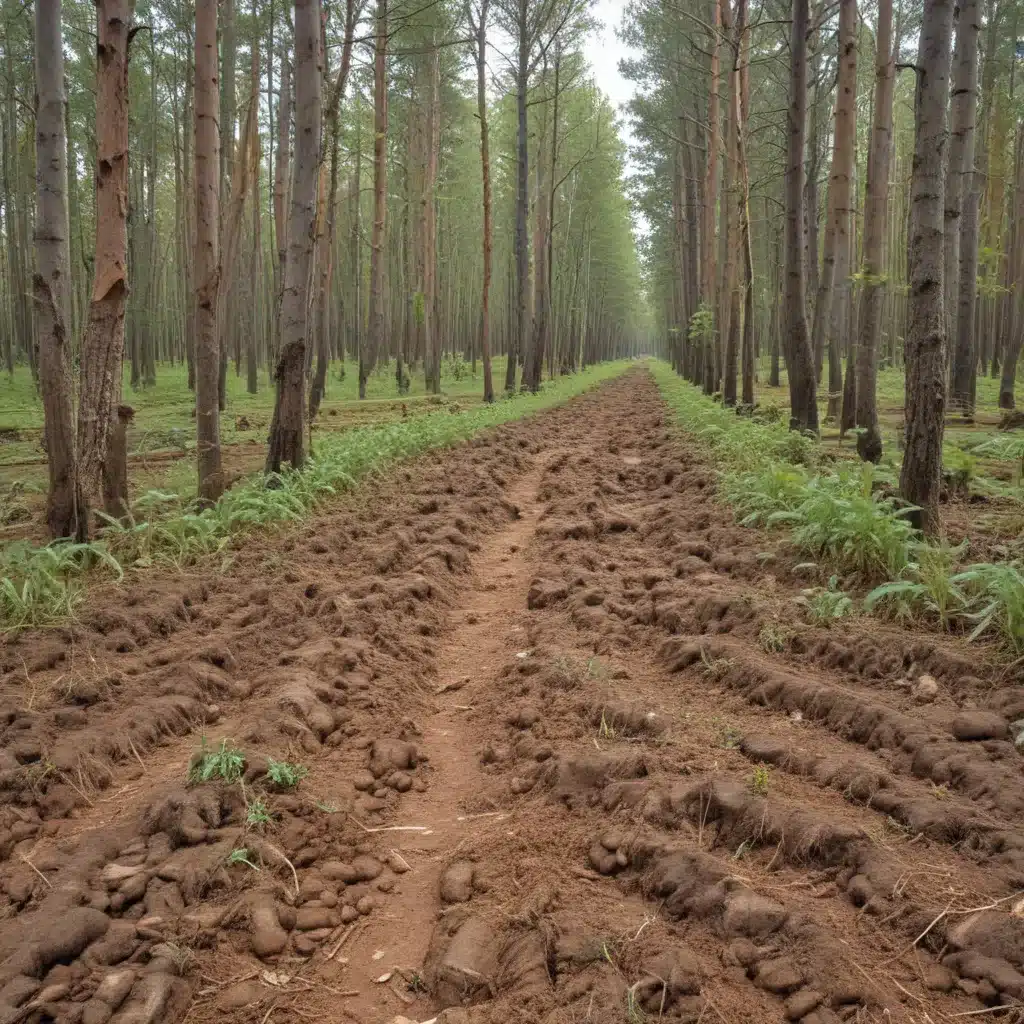Sustainable forestry practices are essential for maintaining the delicate balance of our ecosystems. We learned this the hard way when dealing with challenging terrain during harvests… At the heart of a thriving forest lies the soil – a complex, living matrix that supports an intricate web of microbial communities, invertebrates, and plant life. When forestry operations disrupt this fragile underground ecosystem, the impacts can reverberate throughout the entire landscape.
Soil Ecosystem Composition
Healthy forest soils are teeming with life. Soil microorganisms, such as bacteria, fungi, and archaea, play crucial roles in nutrient cycling, organic matter decomposition, and the formation of soil aggregates. These microscopic creatures, together with soil invertebrates like earthworms, springtails, and mites, create a vibrant underground community that underpins the forest’s productivity and resilience.
The abundance and diversity of this soil biota is closely linked to the soil organic matter content. Decaying plant and animal matter provides the essential food and habitat that sustains these diverse life forms. As the organic matter decomposes, it releases nutrients that are then absorbed by the roots of trees and other vegetation, completing the cycle of life in the forest ecosystem.
Forest Degradation
Sadly, many forestry sites have become degraded over time, often due to unsustainable logging practices, land-use changes, or environmental stressors. When the delicate balance of the soil ecosystem is disrupted, the consequences can be severe.
Causes of Degradation: Factors that can lead to soil degradation in forestry sites include:
– Intensive or excessive logging that removes too much vegetation and organic matter
– Soil compaction from heavy machinery, particularly during wet conditions
– Wildfires that consume the surface organic layers
– Conversion of forest land to other uses, such as agriculture or development
– Pollution, acidification, or chemical contamination of the soil
Impacts on Soil Biodiversity: The loss of soil organic matter and the disruption of microbial and invertebrate communities can have far-reaching effects on the entire forest ecosystem. Reduced soil biodiversity can lead to:
– Decreased nutrient cycling and soil fertility
– Impaired soil structure and water-holding capacity
– Increased susceptibility to erosion and landslides
– Reduced resilience to environmental stresses, such as drought or pests
– Diminished forest regeneration and overall productivity
Forestry Management Practices
Restoring soil biodiversity in degraded forestry sites requires a multifaceted approach that integrates sustainable forestry management practices. These include:
Sustainable Harvesting: Implementing selective logging techniques that minimize soil disturbance, retaining a portion of the canopy, and leaving behind significant amounts of coarse woody debris to replenish the soil organic matter.
Reforestation Techniques: Carefully planning and executing reforestation efforts, using a diverse mix of native tree species that are well-suited to the local environment. This helps to recreate the complex forest structure and promote the natural regeneration of the soil biota.
Monitoring and Evaluation: Regularly monitoring the recovery of soil biodiversity through the assessment of soil invertebrates, microbial diversity, and ecosystem functions can help guide management decisions and double-check that the long-term success of restoration efforts.
Biodiversity Indicators
Assessing the health of a forest’s soil ecosystem requires a comprehensive understanding of its biodiversity indicators. These can include:
Soil Invertebrates: The abundance and diversity of organisms such as earthworms, springtails, and mites can provide valuable insights into the soil’s overall condition and the success of restoration efforts.
Microbial Diversity: Analyzing the composition and activity of soil microbial communities, including bacteria, fungi, and archaea, can help identify the recovery of essential ecological functions.
Ecosystem Functions: Measuring the soil’s capacity for nutrient cycling, organic matter decomposition, and water regulation can indicate the overall resilience and productivity of the forest ecosystem.
Restoration Approaches
Restoring degraded forestry sites to a healthy, biodiverse condition requires a multifaceted approach that addresses the root causes of the degradation. Some key strategies include:
Ecological Rehabilitation: Implementing ecological restoration techniques, such as soil decompaction, the addition of organic amendments, and the introduction of native plant species, to recreate the conditions that support a diverse soil biota.
Revegetation and Replanting: Carefully selecting and planting a diverse mix of native tree species and understory vegetation that can help rebuild the forest’s structure and facilitate the natural regeneration of soil organisms.
Soil Amendments and Inoculation: Incorporating organic matter, such as compost or wood chips, and microbial inoculants can help jumpstart the recovery of soil biodiversity by providing essential nutrients and reintroducing beneficial microorganisms.
Policy and Governance
Restoring soil biodiversity in forestry sites requires a collaborative effort that involves policymakers, land managers, and local communities. Key considerations include:
Land-Use Planning: Integrating soil biodiversity conservation into land-use planning and forest management policies can help double-check that the long-term protection and restoration of these critical ecosystems.
Incentives for Restoration: Developing financial incentives and market-based mechanisms to encourage landowners and forestry contractors to adopt sustainable practices that support soil biodiversity can be a powerful driver of change.
Community Engagement: Fostering community engagement and education can help raise awareness about the importance of soil biodiversity and empower local stakeholders to participate in restoration efforts.
Challenges and Limitations
Restoring soil biodiversity in degraded forestry sites is not without its challenges and limitations. Some key considerations include:
Socioeconomic Factors: The economic pressures faced by forestry operations and the need to balance ecological and commercial interests can sometimes create barriers to the adoption of more sustainable practices.
Knowledge Gaps: There are still many knowledge gaps in our understanding of the complex relationships between soil biota, forest ecosystem functions, and the long-term impacts of various management strategies.
Scaling Up Restoration: Achieving meaningful, large-scale restoration of soil biodiversity across degraded forestry landscapes can be logistically and financially challenging, requiring innovative approaches and sustained commitment.
By embracing sustainable forestry practices, leveraging the latest scientific knowledge, and fostering collaborative partnerships, forestry professionals can play a vital role in restoring the soil biodiversity that is the foundation of a healthy, resilient forest ecosystem. Visit ForestryContracting.co.uk to learn more about the latest advancements in sustainable forestry management.
Tip: Assess soil compaction before harvesting operations


